Hokies probe the heavens:
Alumni are making things happen at the Hubble Space Telescope
by Liz Crumley
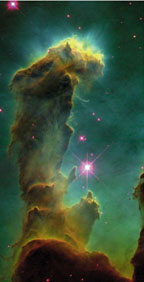
|
Its giant eye, privy to both the ultraviolet and infrared spectra in space, has discovered the fantastic disgorgement of infant stars from the Eagle Nebula, the explosive deaths of aging stars, the inescapable power of black holes, and a planet fleeing its parents.
The Hubble Space Telescope (HST) has made visible the unimaginable.
And, as has been the case since the 1960s when Chris Kraft (aerospace engineering '45) directed NASA's Mission Control during the first lunar flights, dozens of Virginia Tech alumni are playing a powerful role in this latest exploration of space through NASAÕs Goddard Space Center in Maryland. |
|
Gaseous pillars in the Eagle Nebula were seen by the Hubble Telescope.
|
|
Conceived in the 1940s and designed and built in the 1970s and 1980s, the 2.4-meter reflecting telescope was deployed in low Earth orbit by the crew of the space shuttle Discovery in April 1990. NASA had planned to bring Hubble back to earth for regular servicing, but soon realized that servicing in space by shuttle crews would prove less risky for the telescope, says Dan Blackwood (aerospace and ocean engineering '84).
As an engineer from 1985 to 1989 with Lockheed-Martin, a major NASA contractor, Blackwood became part of the team of engineers who planned the initial launch of Hubble and began planning subsequent servicing missions. After that, NASA hired Blackwood as the shuttle interface manager, responsible for coordinating mission planning, managing preparations of the shuttle and crew for Hubble repair work, and leading one of the shifts of the first HST servicing mission.
Soon after the launch in 1990, NASA discovered a major problem with Hubble--the main mirror was ground too flat. Prognoses for the telescope's future ranged from fixable to fiasco.
Enter Paul Geithner (electrical engineering '84), a former member of the corps of cadets, who was hired by NASA in 1991 as a Hubble engineer. In 1992, Geithner was assigned to correct the optical aberration.
"In a perfectly ground telescope, all light focuses on one point," he says. "But Hubble was about one-fiftieth of a hair too flat."
Although the mirror was flawed, regrinding it was not the solution. Geithner's engineering team solved the problem in two ways. It replaced the original wide field planetary camera with another one deliberately flawed to correct for the mirror's aberration; the big mirror is two microns too flat at the edge, so the new camera has mirrors two microns too high.
The team also replaced the high-speed photometer (used to measure light intensity) with a package of optics designed to correct the effects of the big mirror's aberration on the faint object camera, faint object spectrograph, and Goddard high resolution spectrograph
The installations were done by the crew of the space shuttle Endeavour in December 1993. This was the toughest assignment ever given a shuttle crew, and the astronauts spent a record-setting 35 hours and 28 minutes outside the craft in space to carry out the project. With the servicing mission successfully completed, astronomers at last were able to cast Hubble's remarkable eye on faint objects in the ultraviolet range of the spectrum. Startling photographs of the Eagle Nebula were among the results.
1997 mission
A second servicing mission was undertaken in February 1997 to install new instruments that enable Hubble to provide infrared imaging and more detailed observations. Numerous Virginia Tech alumni were hard at work at this endeavor as well.
As shuttle interface manager and deputy servicing mission manager, Blackwood assisted with mission planning and coordinated the preparation of the shuttle and the crew for their Hubble repair work.
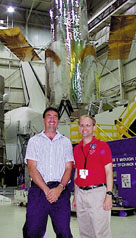 |
Bob Ritter(mechanical engineering '81) is responsible for analyzing the shuttle's environment, designing appropriate hardware for the shuttle's interface with Hubble, and overseeing the loading of the four carriers located in the shuttle payload bay. The greatest challenge of the Hubble project, Ritter says, is working with different agencies and contractors. "Everyone has their own criteria," he says. "My engineering education at Tech comes in handy--I learned how to work as part of a team."
Rich Fink (mechanical engineering '82), a Lockheed-Martin engineer works with Hubble's Extra-Vehicular Activity (EVA) office, making sure that new equipment and scientific instruments are designed to be installed on-orbit. "When the shuttle crew sleeps, people on the ground work around the clock to prepare for the next day's work in space," he says. |
| NASA engineers Bob Ritter and Dan Blackwood stand in front of a full-sized mock-up of the Hubble Space Telescope and Shuttle. |
|
Part of Fink's job is to don a space suit and team up with NASA astronauts to evaluate hardware designs in the space agency's Neutral Buoyancy Laboratory. The lab's water tank contains a full-size mockup of the shuttle's payload bay and of Hubble, enabling test subjects to evaluate hardware and develop procedures in a simulated zero-gravity environment. "In the tank, I learn first-hand about the special problems the astronauts face, not the least of which is the endurance required to work for six hours at a time in a space suit, where the flexing of each muscle is met with resistance," says Fink.
Fink also briefs the astronauts regarding constraints and hazards associated with instrument replacement, and he sits at the Mission Control console during servicing missions to help deal with problems. During the 1997 mission, a surprising amount of degradation was discovered in HST's external thermal blankets. "We had to figure out ways for the crew to repair the blankets using whatever extra pieces of hardware they had on board," Fink says.
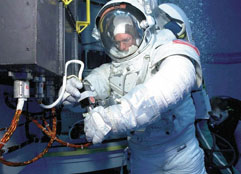 |
Rich Fink dons a space suit to help astronauts evaluate hardware designs in NASA's underwater Neutral Buoyancy Lab. |
Preparing for the unexpected is serious work at NASA. For a year before each mission, Fink and other Hubble engineers work with their counterparts at the Johnson Space Center in Houston to simulate potential emergencies. "The year of simulation training is pretty intense," he says. "Several lives and national assets hang in the balance." During the third servicing mission in 2000, the astronauts will have at least six days of EVA work on Hubble, and Fink and his colleagues will spend a good part of 1999 simulating every detail of those days.
"My job has given me a great appreciation for our astronauts," Fink says. "The training it takes to reach that level of capability is incredible."
Heather Saunders (aerospace and ocean engineering '93) aims to tackle that training. In fact, she enrolled at Virginia Tech with the goal in mind of becoming an astronaut. "It's the most honored part of NASA's program," says Saunders, 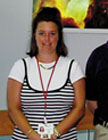 who went to work for NASA contractor Allied SignalAerospace immediately after graduation. Saunders started her career as an operations controller.
who went to work for NASA contractor Allied SignalAerospace immediately after graduation. Saunders started her career as an operations controller.
"The telescope has to be monitored 24 hours a day," she says. "I spent my first year at NASA making sure that Hubble was pointed in the right direction." In 1994 and 1995, she worked with Blackwood as a servicing mission engineer and developed the command plans for the 1997 mission. In 1996, Saunders joined Lockheed-Martin and became a mechanical engineer with the Hubble Structures Group. She performs structural integrity analyses of Hubble and the new components that will go up in the shuttle. "I work some with Rich Fink, providing him with information about how scientific instruments must be installed during the mission," she says. "Installation of these components has to be precise."
In 1997, Saunders earned an MS in mechanical engineering with a specialty in aerospace from George Washington University, where she is now working on a Ph.D. in aerospace. She already has achieved two of the four requisites to apply for astronaut training--she has both a pilot's license and scuba diving license. Before she can apply for astronaut training, she has to be employed by NASA, rather than a contractor, and complete her Ph.D., which she will do in about four years. "NASA puts the applicants through rigorous interviews and physicals," says the shuttle crew hopeful. "Only about 100 are chosen as astronauts in training, and not all of those become astronauts. Those that do have to train for years before being sent on a mission."
Saunders isn't daunted by this obstacle course. She recalls something Virginia Tech professor Jim Marchman said to her when she had trouble with the material in one of his classes: "Just keep trying, and you'll make it."
From Hubble to the next generation
| One of the major tasks of the 1997 servicing mission was the installation of the near infrared camera and multi-object spectrometer (NICMOS), which has enabled Hubble to detect light in the long wave length, infrared range of 0.8 to 2.5 micrometers. "NICMOS, like night-vision goggles, gave Hubble the ability to see through smoke and dust," says Geithner, who led the NICMOS project for NASA. "Stars are born in clouds of dust, and NICMOS can look through those clouds." One of the most fascinating findings of NICMOS is what appears to be a rogue planet, photographed in May 1998 while hurtling away from its parent stars through interstellar space.
|
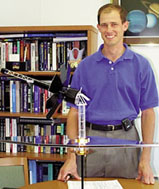
|
|
Paul Geithner is responsible for correcting the Hubble Space Telescope's 1990 optical aberration. He is standing behind his newest project, a model of NASA's Next eneration Space Telescope. |
After the 1997 mission, Geithner and Blackwood moved on to NASA's Next Generation Space Telescope (NGST) project. Hubble will remain in orbit until 2010 and will have two more servicing missions, Blackwood says. NASA plans to launch the NGST in 2007 on an Atlas launcher to a point about one million miles from earth called L2, where the juxtaposition of the earth, moon, and sun cancel the effect of gravity to provide a stable orbit.
"There won't be any servicing missions to NGST," says Blackwood, who, along with Geithner, is in charge of integrating all engineering studies being conducted for the project.
The goal of the NGST project is to observe the first stars and galaxies and learn more about the origins of the universe. With a diameter of eight meters compared to Hubble's 2.4 meters and using an advanced version of NICMOS, this telescope a million miles from earth will see further back in time than Hubble.
"Think of the universe as a loaf of raisin bread," says Geithner, who is chief systems engineer for the project ("Kind of like being Scotty on Star Trek," he jokes). "As the loaf expands, all the raisins move away from each other, the farthest moving the fastest." Because of a phenomenon called the Doppler Shift, light waves from distant stars and galaxies are moving away so fast that their light is not visible anymore except in the infrared end of the spectrum. "NGST will explore a whole region of space and time for which we now have no data," Geithner notes.
And the next step after NGST, which NASA plans to operate from 2007 to 2017? "An array of NGSTs that can detect and photograph earth-sized planets," Geithner predicts. Or perhaps the long-awaited sightings of life on other planets?
A Listing of Hubbell Space Telescope Engineers with Virginia Tech degrees
Acey Herrera (BS AE '92)
Keith Rosette (BS AE '91; MS ME '94))
Tim Zukowski (BS PHYS '84)
Allen Crane (BS AOE '85)
Tina Baucom(BS ESM '87, MS '88)
Brian Marland (BS ME '94)
J.B. Joyce (BS MATH '64)
Judy Yienger (BS ME '92)
William Haile (BS ESM '62, MS '65, Ph.D. '67)
Jon Lawrence (BS ME '84)
Gerry Repass (BS MATH '62)
Michael Max (BS EE '90)
Janis Oandasan Lusco (BS ME '90)
Paul Kirchman (BS CE '81)
Jiaying Wang (BS ESM '82)
Harlan Bowers (BS AOE '83)
Mike Honaker (BS AOE '80)
Leonard Olson, Jr. (Ph.D. PHYS '74)
James Folk (BS EE '85)
Richard Brewster, Jr. (MS SYSE '90)
Satya Anandakrishnan (MS AOE '83)
Kris Brown (BS CE '82)
Bruce Wagner (BS MATH '87)
Carroll Dudley (BS EE '62)
Ray Pages (BS EE '84)
Matthew Erb (BS CPE '97)
Tom Stengle (BS AOE '77)
This listing may not be complete, as other alumni may have joined the project in the past year.
Back to Features Page
Home | News | Features | Research | Philanthropy | President's Message | Athletics | Alumni | Classnotes | Editor's Page




 who went to work for NASA contractor Allied SignalAerospace immediately after graduation. Saunders started her career as an operations controller.
who went to work for NASA contractor Allied SignalAerospace immediately after graduation. Saunders started her career as an operations controller.